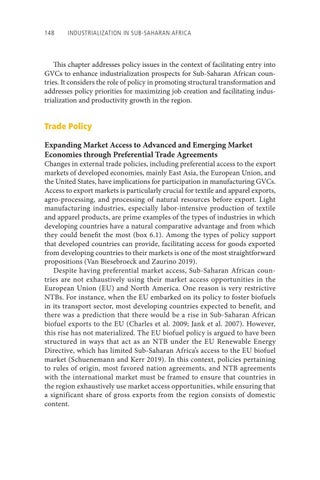148 Industrialization in Sub-Saharan Africa
This chapter addresses policy issues in the context of facilitating entry into GVCs to enhance industrialization prospects for Sub-Saharan African countries. It considers the role of policy in promoting structural transformation and addresses policy priorities for maximizing job creation and facilitating industrialization and productivity growth in the region.
Trade Policy Expanding Market Access to Advanced and Emerging Market Economies through Preferential Trade Agreements
Changes in external trade policies, including preferential access to the export markets of developed economies, mainly East Asia, the European Union, and the United States, have implications for participation in manufacturing GVCs. Access to export markets is particularly crucial for textile and apparel exports, agro-processing, and processing of natural resources before export. Light manufacturing industries, especially labor-intensive production of textile and apparel products, are prime examples of the types of industries in which developing countries have a natural comparative advantage and from which they could benefit the most (box 6.1). Among the types of policy support that developed countries can provide, facilitating access for goods exported from developing countries to their markets is one of the most straightforward propositions (Van Biesebroeck and Zaurino 2019). Despite having preferential market access, Sub-Saharan African countries are not exhaustively using their market access opportunities in the European Union (EU) and North America. One reason is very restrictive NTBs. For instance, when the EU embarked on its policy to foster biofuels in its transport sector, most developing countries expected to benefit, and there was a prediction that there would be a rise in Sub-Saharan African biofuel exports to the EU (Charles et al. 2009; Jank et al. 2007). However, this rise has not materialized. The EU biofuel policy is argued to have been structured in ways that act as an NTB under the EU Renewable Energy Directive, which has limited Sub-Saharan Africa’s access to the EU biofuel market (Schuenemann and Kerr 2019). In this context, policies pertaining to rules of origin, most favored nation agreements, and NTB agreements with the international market must be framed to ensure that countries in the region exhaustively use market access opportunities, while ensuring that a significant share of gross exports from the region consists of domestic content.

